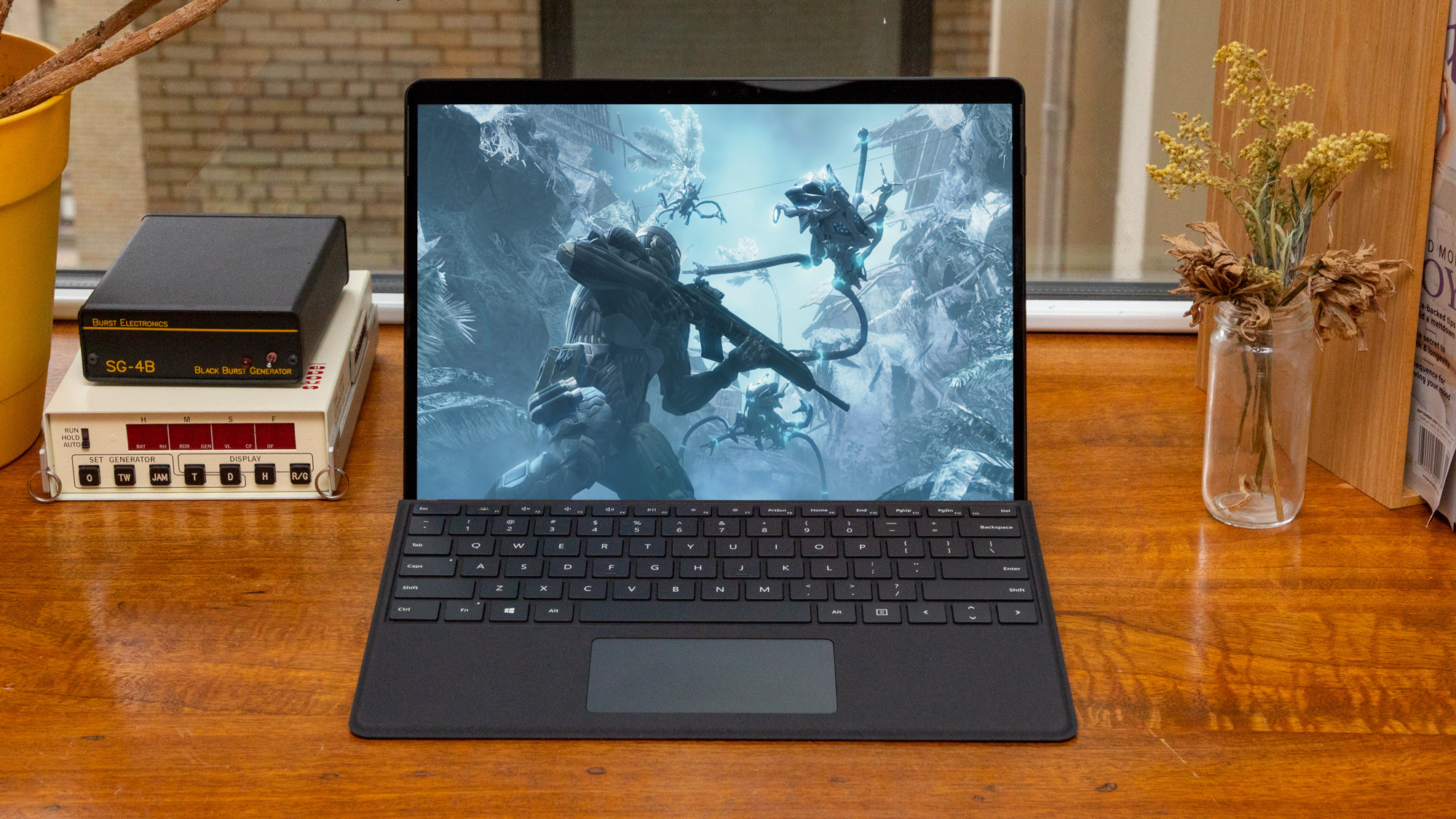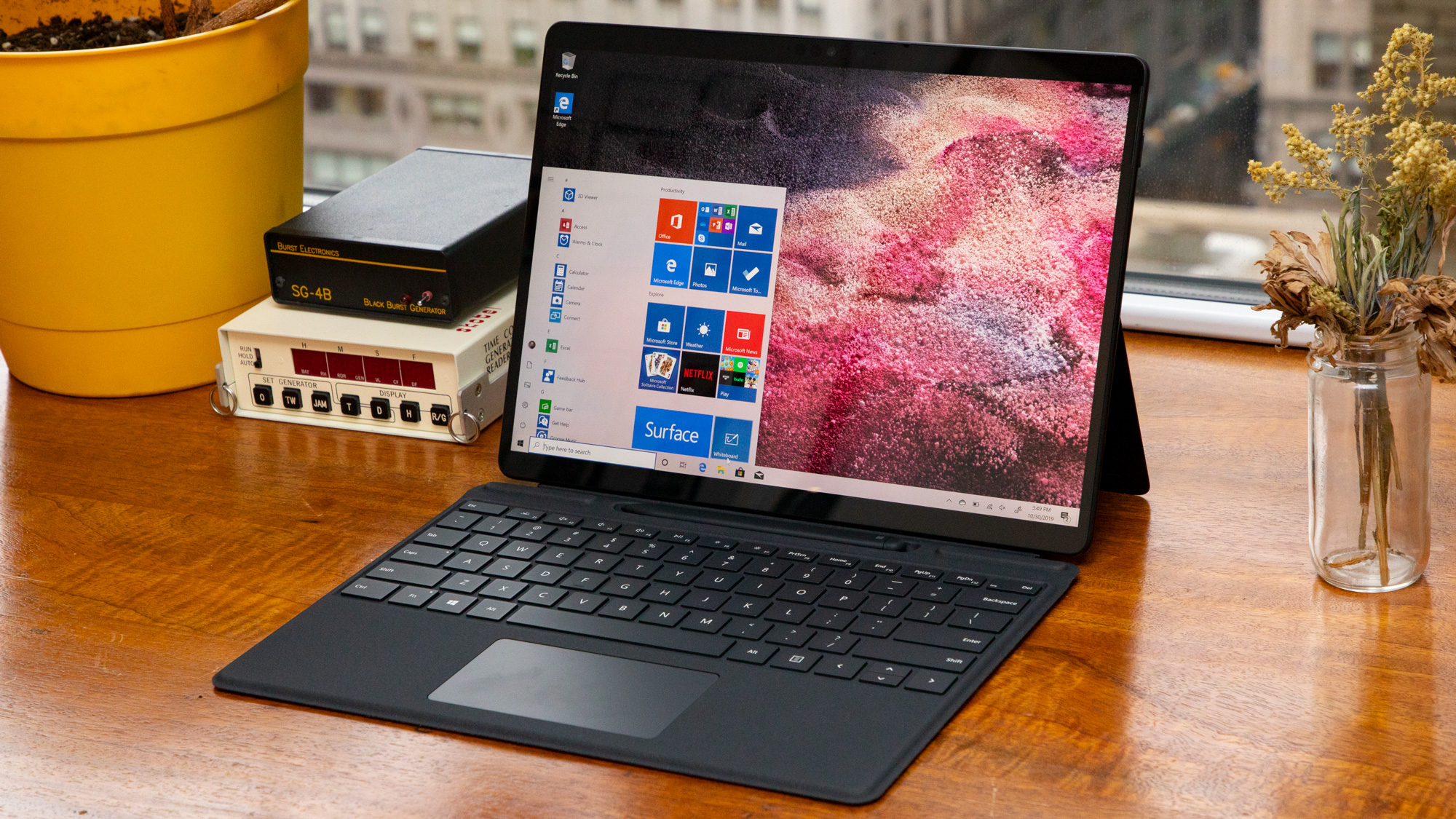Can the Surface Pro 7 play Crysis?
Yes. Yes it can.

Tablet gaming has always been faintly frowned upon by gamers from all walks of life. PC and console gamers are quick to put it in a box with mobile gaming, citing lacklustre graphics and a toxic dependency on microtransactions.
Meanwhile, mobile gamers jest about the bulky size of tablets that run glorified smartphone processors.
We're not here to stir up animosity between those two camps, though. We're here to say that the tablet will be ridiculed no longer: the arrival of Intel’s 10th-gen mobile processors is changing the game.
We recently tested out the new Surface Pro 7, running a handful of game benchmarks on it as part of the process.
To our surprise, it handled them pretty well – at least, far better than the older Surface Pro 4, packing an Intel Core m3-6Y30. So, we went ahead and tried actually playing a game on it. Then another… then another. Before long, we were testing out half of our Steam library on this dinky little sliver of technology.

Tablet graphics are no longer a laughing matter
Before we get into the nitty-gritty details of gaming on a Surface tablet, let’s have a quick recap of tablet graphics.
While there do exist tablets and convertible laptops with discrete GPUs (typically low-powered graphics cards like Nvidia’s GeForce MX series), the vast majority get along with integrated graphics baked into the processor. That’s fine for your everyday tablet use; modern CPUs with integrated graphics can handle the majority of simple work tasks.
Get daily insight, inspiration and deals in your inbox
Sign up for breaking news, reviews, opinion, top tech deals, and more.
For gaming, though, integrated graphics are rarely sufficient. Desktop CPUs have made leaps forward in recent years, with the new Ryzen 5 3400G processor from AMD using Radeon RX Vega 11 graphics to decent effect. However, mobile parts have struggled to keep up; especially considering that AMD’s Vega technology is relatively scarce in the tablet market, with most tablets either using Intel’s laptop parts or Qualcomm’s mobile chips.
Intel’s 10th generation of laptop and mobile CPUs hit earlier in 2019, and it brought with it the usual slew of minor performance improvements. But there was one other thing; Intel’s old integrated graphics technology - annoyingly simply named Intel Graphics - was gone, replaced with the shiny new Iris Plus Graphics.
An evolution of the underutilised Iris Pro, found in some Skylake-series processors, Iris Plus is the graphical technology that powers the Surface Pro 7, specifically via the Core i7-1065G7 CPU inside the model I’m testing.
Right off the bat, Iris Plus blows Intel’s older graphics out of the water. The first couple of games we tested (Shadow of the Tomb Raider and Ghost Recon: Wildlands) bring back relatively conservative figures at 1080p Ultra settings, but dropping the graphical fidelity down to Low or Medium sees us hit playable framerates (that’s 30fps and above for any performance PC fiends reading this).
Suitably encouraged, we pushed on and tried out other games, trying to find the Surface Pro 7’s breaking point. As you might have guessed, that breaking point was Crysis.
A Crysis of confidence
We did actually get Crytek’s seminal PC-breaker running. 1080p Ultra settings prompted an immediate crash after the opening cutscene, and Medium didn’t fare much better, coming out horribly laggy.
Dropping the settings right down to the lowest options available, though, and it managed a sturdy 45 frames per second, allowing me to stealthily pick off enemy soldiers as I stalked across Lingshan Island with the help of a wireless mouse.
Yes, we’ve seen Crysis lovingly rendered on an RTX 2080 Ti. No, this doesn’t even come close. But it’s certainly playable, and even on the Surface Pro 7’s little screen it still manages to capture some of the magic that makes the game still feel like a classic.
Of the other games we played, a few stood out: Dirty Bomb looked and felt great, allowing us to eke out a few multiplayer victories, while Everspace brought us glorious exoplanetary scenery to admire on the Surface Pro 7’s 12.3-inch display. Even the scuffles of Overwatch played reasonably well at lower settings.
Looking at raw performance data, Iris Plus more than doubles the potential framerates offered by the 9th gen’s Intel UHD Graphics 620. That doesn’t make every game playable – doubling 5fps isn’t going to work, sadly – but many games that weren’t quite viable on the previous generation now run perfectly well.
Demanding new triple-A titles aren’t really an option, mind you. Control was a stuttering mess at 1080p on Low settings, and The Outer Worlds was better but prone to choking during busy skirmishes. Meanwhile, Rainbow Six Siege and The Witcher III: Wild Hunt both refused to run altogether.

The same goes for CPU-bound games; not all genres were created equal in the eyes of Iris, with large-scale RTS titles like Total War: Warhammer II really struggling even at the lowest settings.
We tested some games in 720p, but the Surface Pro’s display didn’t like that much, so performance gains were frequently offset by wonky aspect ratios or cropped in-engine cutscenes.
Storage quickly became an issue, too; the Surface Pro 7 model we were using only had a 256GB M.2 drive, so we had to uninstall games before we could download and try out more. That SSD is a double-edged sword, though, as the M.2 NVMe meant that any load times in games were speedy as hell.
Now, we know some people are going to nitpick over the definition of the Surface Pro 7 as a ‘tablet’. There are arguments to be made that it’s a convertible laptop instead, doing the same job as any of the best 2-in-1 laptops. Yes, it runs Windows 10 and has a physical keyboard, but your average laptop doesn’t let you detach said keyboard and go full tablet mode.
What does this mean for the future of tablet gaming? Windows-ready tablets are still something of a rare breed, but with more games arriving on mobile operating systems (like Fortnite, for example), Intel-equipped tablets will be capable of keeping up with laptops. As mobile gaming is further legitimised by big developers bringing their IPs to iOS and Android, the potential for powerful gaming in ultralight systems will only grow.
Another takeaway here is that integrated graphics as a whole are improving; Intel’s 10th generation of desktop CPUs will hit soon, and those chips could shake up the PC gaming world something fierce.
Competent gaming PCs and laptops that run solely on Iris Plus graphics would be cheaper, quieter and more power-efficient than their discrete-GPU counterparts. Needless to say, we're excited to see what comes next.
- These are the best PC games to play right now

Christian is TechRadar’s UK-based Computing Editor. He came to us from Maximum PC magazine, where he fell in love with computer hardware and building PCs. He was a regular fixture amongst our freelance review team before making the jump to TechRadar, and can usually be found drooling over the latest high-end graphics card or gaming laptop before looking at his bank account balance and crying.
Christian is a keen campaigner for LGBTQ+ rights and the owner of a charming rescue dog named Lucy, having adopted her after he beat cancer in 2021. She keeps him fit and healthy through a combination of face-licking and long walks, and only occasionally barks at him to demand treats when he’s trying to work from home.